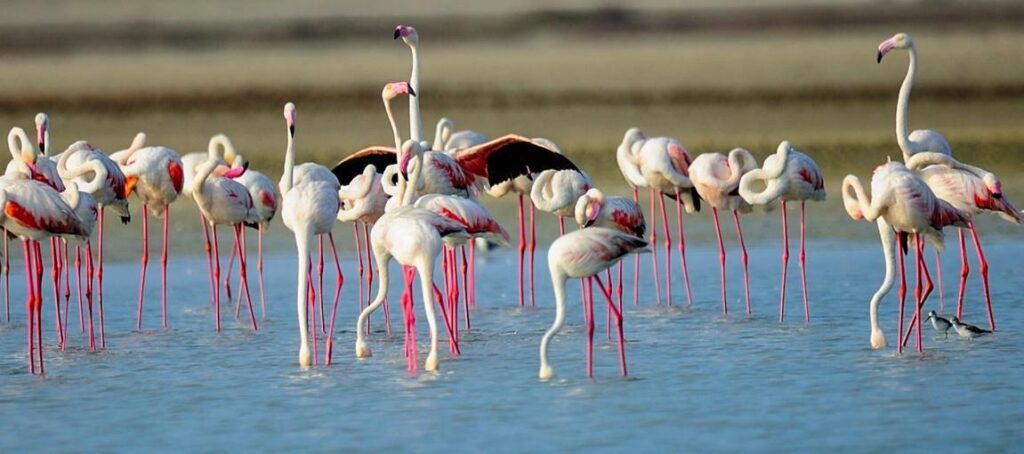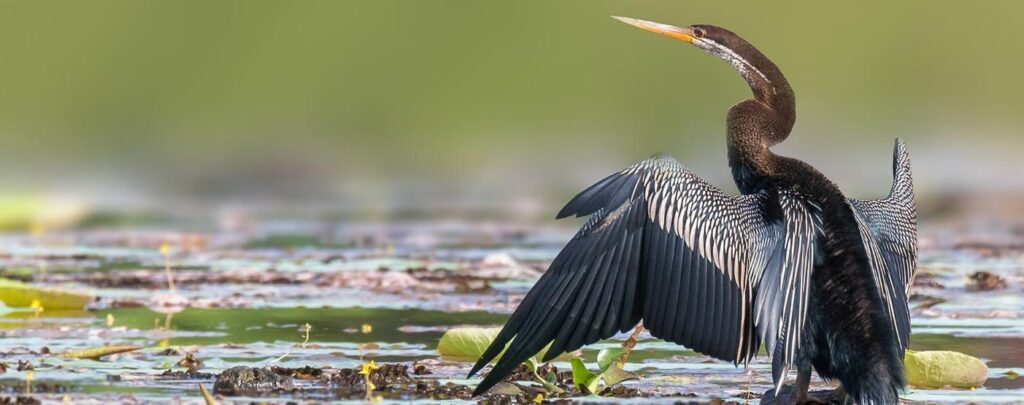Physical Address
23,24,25 & 26, 2nd Floor, Software Technology Park India, Opp: Garware Stadium,MIDC, Chikalthana, Aurangabad, Maharashtra – 431001 India
Physical Address
23,24,25 & 26, 2nd Floor, Software Technology Park India, Opp: Garware Stadium,MIDC, Chikalthana, Aurangabad, Maharashtra – 431001 India

Climate change is one of the main threats that is challenging the environment. So, people apply many solutions to mitigate and adapt to climate change. However, some of these solutions are considered to have ‘side effects.’ Invariably, when a new solution comes forward, the pros and cons of that are being talked about.
Recently, India’s Adani group plans to build a new wind power plant in the Mannar area in Sri Lanka. However, environmentalists have commented that this power plant may cause damage to the environment. They have mentioned that this power plant will thoroughly impact the migratory birds in the Mannar area.
India’s Adani Green Energy Power Plant in Sri Lanka
Adani Green Energy Ltd is an Indian Company. With Sri Lankan government approval, in 2022, Adani Green Energy has planned for two wind power projects in Mannar and Pooneryn areas in the Northern province of Sri Lanka to deliver 286MW and 234MW for an investment of over USD 500 million. These plans are based on the renewable energy project to generate 500 MW in Sri Lanka’s north and eastern regions.
However, according to the tweets of the Energy and Electricity Minister, Mr Kanchana Wijesekara, last year, Adani Green Energy planned to complete this project by December 2024.

This wind power plant, named ‘Thambapavani’, is planned to be built on the southern coast of Mannar Island. Here is the location of the wind power plant.

Wind Energy in Sri Lanka
Wind energy is harnessed from the kinetic energy of wind through wind turbines, which convert it into electricity. It’s a renewable and clean energy source increasingly utilised worldwide to reduce reliance on fossil fuels and combat climate change. In Sri Lanka, there are about 15 wind farms(most are small-scale).
Wind power is one of the most important energy sources in Sri Lanka. Sri Lanka is a country that heavily relies on imported fossil fuels for its energy needs. Wind power provides an opportunity to diversify its energy sources, reducing dependence on imports and enhancing energy security. Also, Sri Lanka faces environmental challenges, including air and water pollution. Wind power offers a clean and renewable alternative to fossil fuels, helping to reduce carbon emissions and mitigate climate change impacts.
Investing in wind power can lead to long-term cost savings compared to importing expensive fossil fuels. Once wind turbines are installed, the operational and maintenance costs are relatively low, making wind energy a cost-effective option in the long run. Sri Lanka has significant wind energy potential, especially in coastal and high-altitude regions. Developing wind power projects in such areas can stimulate rural economies by creating job opportunities and attracting investment. As Sri Lanka’s economy grows and its population expands, there is a corresponding increase in energy demand. Wind power can sustainably help this growing demand for electricity without depleting finite resources.
Wind power is one of the most effective energy sources for Sri Lanka as it has considerable potential for wind power generation, particularly along its coastal areas and in certain hilly regions.
Climate change is one of the significant threats in Sri Lanka. At the same time, we are finding solutions using renewable energy sources that emit minimum greenhouse gases to minimise greenhouse gas emissions. Wind power is the best alternative for this in our country. Here is an article on how wind power supports our environment.

While constructing a wind power plant, one of the main challenges that are being faced is finding a suitable location. Wind power plants need strong wind patterns almost every day throughout the year. Even though Sri Lanka has proper geographical and topographical characteristics, finding a place that fulfils every need for an effective wind power plant is tough. While selecting a location, choosing an area with minimum visual and environmental impacts is essential. Wind turbines can alter visual landscape and may have environmental impacts, such as noise pollution and disruption to wildlife habitat.
So, installing a wind power plant should be done very carefully.
Migratory Birds in Mannar
Some birds cannot survive in the winter periods in their habitats because of a lack of food and extreme conditions. So, they travel a long distance towards warmer regions such as tropical countries from the cold habitats. This process is called the migration of birds.
Sri Lanka is one of the great destinations for migratory birds worldwide due to its diverse habitats, including wetlands, forests, and coastal lines, which provide abundant food and nesting sites. Its strategic location along bird migration routes makes it a crucial stopover point for many species travelling between breeding and wintering grounds. Additionally, the island’s tropical climate and favourable environmental conditions make it a migratory destination for birds.
We contacted Sri Lankan ornithologist Prof. Sampath Seneviratne for ideas on migratory birds in Sri Lanka, especially in the Mannar area. According to Prof. Sampath Seneviratne, there are eight main pathways of migratory birds worldwide. Usually, around one billion birds fly through each path. From September to October, they fly towards the south, and from March to April, they fly towards the north.
Sri Lanka is in the middle of one of those pathways. This pathway is known as the Central Asian Flyway. Birds from about 30 countries fly through this pathway. Most importantly, Sri Lanka is at the lowest point of this Central Asian Flyway. That means the next land area if those birds fly downwards, will be Antarctica, which is about 8000 to 9000 km away from the land of Sri Lanka. So, the large number of birds who fly through the Central Asian Flyway should stay in Sri Lanka as their final destination.

About one billion migratory birds fly in this Central Asian Flyway. It is estimated that 15 million birds come to Sri Lanka annually from them. These 15 million birds enter the country through three main entrances. Mannar is one of those entrances.

Prof. Sampath Seneviratne explained that around 1 million out of 15 million of the migratory birds in Sri Lanka spend their migratory season in the Mannar island area.
In this season, bird watching is an exciting thing to do in Mannar. Migrated greater flamingos, black-tailed godwits, gulls, pintail ducks, plovers, terns, and many other birds can be seen in flocks of several hundred.

Mannar is a good area for migratory birds because of its geographical location along the Central Asian Flyway, providing a crucial stopover point for birds travelling between breeding and wintering grounds. Additionally, its diverse habitats, including wetlands, salt pans, and scrublands, offer abundant food resources and birds shelter during their journey.
How Do the Wind Farm Affect Migratory Birds in Mannar?
Migratory birds can be affected by wind farms in a few ways. They might collide with the turbines, especially if they fly at night or in low visibility. Additionally, habitat disruption and changes in migration patterns due to wind farms can also impact them.
According to the records, wind turbines cause more than 400,000 birth deaths annually in the US

We contacted conservation biologist Mr Himesh Dilruwan Jayasinghe to get an idea. He was also an expert who involved into the biodiversity surveys in area to advice government on the planning process of this plant.According to him, there are few suitable sites for wind farm installation in Sri Lanka. The coastal area from Kalpitiya to Jaffna is one of them. The other site is Ambewela, which has highland wind patterns. But, when comparing the infrastructure and other conditions in these two regions, coastal areas in North Western Sri Lanka are more appropriate for an effective wind power plant. That is why this area was selected for the wind power plant in the first place.
When the constructors plan and map the wind turbine tower installation, they must consider the proper locations to get more effective power. But when it comes to a practical level, some of the mapped areas are typical habitats for many migratory birds, and installing wind towers may challenge biodiversity in this area by habitat disruption. According to Mr Himesh, with the research and support of environmentalists and conservation biologists, they have shifted the tower location to avoid these critical hot spots. Significantly, if any tower was mapped in wetlands, the habitats for waders were moved to a place with less impact or wholly removed. Also, the Mannar area has few freshwater bodies, as many water sources consist of salty water. So, these freshwater bodies are rare and vital to save without interference to protect the flora and fauna species living there. So, such freshwater bodies were kept completely untouched alongside the wind farm construction.

The Mannar wind power plant project is under three phases. Phase one is already completed. Mr Himesh Jayasinghe said that phase one of the wind power plant was conducted based on the scientists’ research data to minimise the impact of habitat disruption. So, the habitat damage of the Mannar area for migratory birds and other animals is kept at a minimum level as much as possible.
Now, phase two will be conducted with the preceding data and experience from phase one.
Mr Himesh commented that they also thought the most significant damage for the migratory birds would be done through the accidents with the wind turbines in the beginning. So, they have located the towers in areas with minimum bird density and implemented different solutions to decrease this damage. However, after completing phase one, they found another severe issue.
Wind turbines are built on Mannar Island, and the power generators should be dragged onto the mainland. In phase one, power transmission lines were used to interlink the wind turbine to the mainland. Transmission lines electricity at high voltage over long distances from wind turbines to areas where the electricity is needed. Many of the migratory birds near Mannar Island were killed by accidentally colliding with these transmission lines.

Mr Himesh mentioned that he was also in the bird survey of the Mannar island wind power project phase one, and one of the main things they noticed was birds which harmed the transmission lines the birds which flew back and forth to the main island and Mannar island, especially for foraging, such as raptors.

So, raptors and smaller birds were commonly killed by these accidents, according to the survey.
However, Mr Himesh Dilruwan Jayasinghe mentioned that, in phase two, there are plans to avoid this issue as well. The transmission lines will be moved along or under the earth. So, birds decrease the chance of entangling or crashing with those lines. Mr Himesh also said it would be better to convert the transmission lines from phase one into this method. But this process is more expensive.
Government Attempt to Conduct the Wind Farm Project in Mannar Balanced
As mentioned above, sustainable energy types like wind are essential and influential in islands like Sri Lanka. Global warming is widely talked about using sustainable and renewable energy sources. So, the wind farm project in Mannar can be described as a significant step towards sustainable energy. However, this project is considered a project that should be controlled thoroughly by the government to make it more sustainable. We contacted the Chairman of the Sustainable Energy Authority, Sri Lanka, Mr. Ranjith Sepala.
He also mentioned how vital wind farms are to Sri Lanka. While fossil fuels such as diesel cost about Rs.65-100 per electricity unit, wind energy only costs less than Rs.30 per unit.
Mr Sepala said that the Sustainable Energy Authority had done numerous types of research on migratory and local birds’ behaviour before this project and that research is continuing. With this research, they have paid attention to birds’ landing areas, habitats, nesting behaviours, foraging, and how they conduct their transmissions. The research article on this was published recently as well. According to Mr Sepala, three main bird habitats are rich in biodiversity in Mannar. They are Talaimannar, Vankalai and Wedithalathivu. These areas are considered as their landing areas. These three leading habitats are kept untouched so that this energy project does not impact these areas. Based on these actual data, the wind farm is planned with the guidance of environmentalists and biologists.
However, Mr Ranjith Sepala said that as a government institution, the main goal of the Sustainable Energy Authority is to focus not only on the limited sustainability of the energy source but also on the sustainability of every related organism and environment. That is why they have researched and used older data on similar projects. He said that government institutions are managing this project as they need to keep this quality in the project and its related background, such as the environment and animals.
Based on this research, international standards, and previous experiences, many solutions have been implemented in this power plant. The blades of the wind turbines are painted in colours which are more noticeable to birds. According to present standards, they are black, so birds can notice these blades quickly and avoid them before they are met with an accident. Here is more on that.

Also, Mr Sepala said these wind turbines have sensors that can sense the birds approaching them. After sensing that, these turbines are designed to stop rotating. Though this causes a loss of energy production, it may help to save birds.
He said that, as Mannar and related areas are landing areas for birds, birds try to fly a bit lower in these areas. It is lower than the levels of wind turbines. This is also a reason to have less damage to birds in Mannar.
Finally, Mr Sepala said that this project is well planned with all the details on migratory birds and biodiversity. These plans are prepared to make minimum damage to higher effective power production. He said it would be better if someone paid attention to Sri Lankan elephants and other animals in this way and protected them as well because it is possible that a better plan based on research and experiences can save animals without pressuring the country’s development.
Conclusion
The wind power plant project on Mannar island is significant to Sri Lanka, primarily as a solution for global warming and to provide a continuous and sustainable power supply in the country. Mannar is one of the most suitable sites for this project as well. However, migratory birds can be affected by this project. However, habitat disruption has been minimised with experts’ knowledge and research data. But, the ability for accidental deaths of migratory birds is there. Anyway, the experts have tried to mitigate these issues in several ways. That does not mean there is no harm to migratory birds by this power plant. This power plant impacted several ways of migratory birds and their migratory patterns. But the government tries to minimise that effect on our environment.
-With inputs from Mihiri Sparamadhu–
Comments are closed.
XeZyAqPGDgCW
DpQTKlOzhcIu